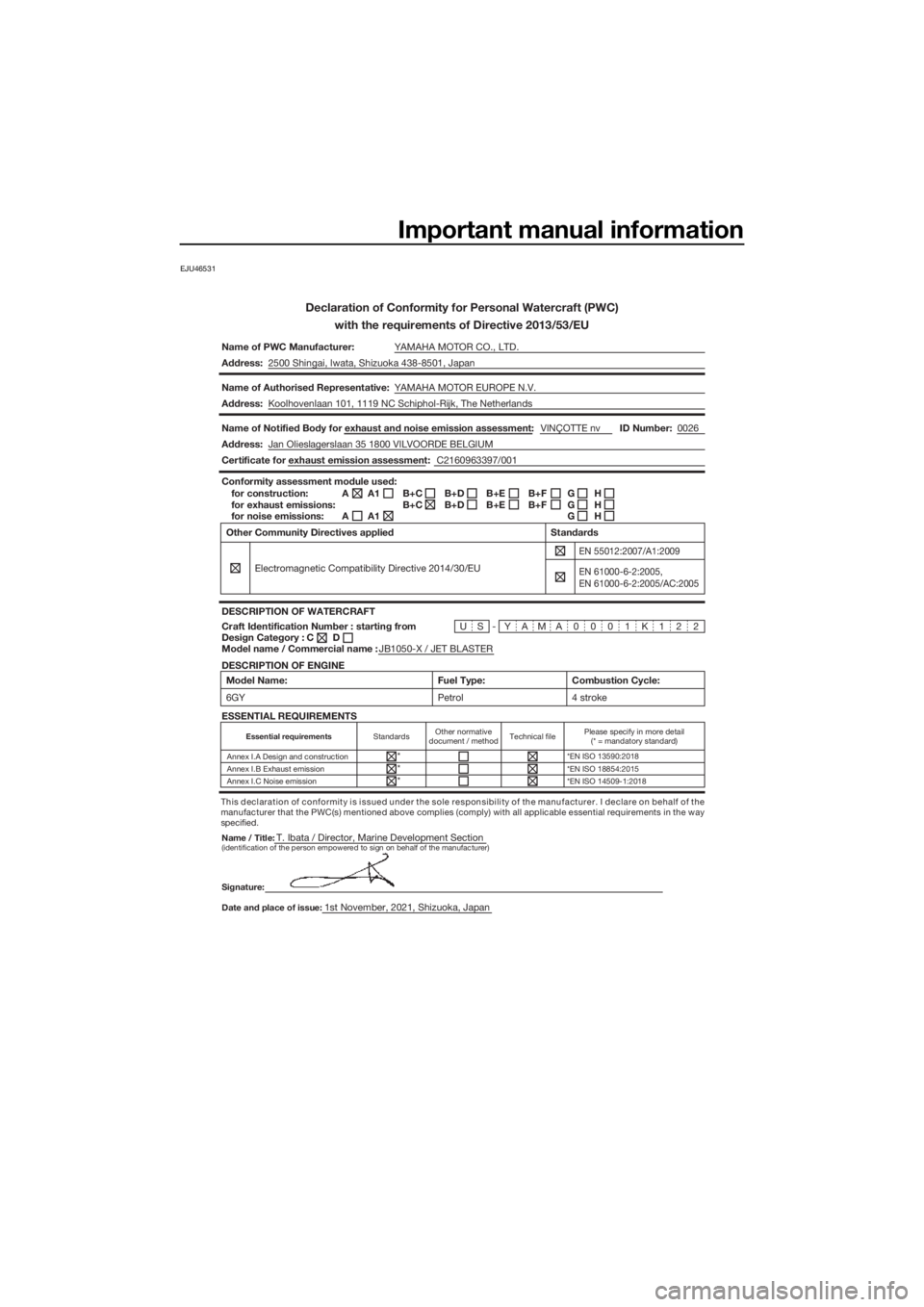ESP YAMAHA JETBLASTER 2022 Owners Manual
[x] Cancel search | Manufacturer: YAMAHA, Model Year: 2022, Model line: JETBLASTER, Model: YAMAHA JETBLASTER 2022Pages: 98, PDF Size: 4.83 MB
Page 3 of 98

Important manual information
EJU46531
Declaration of Conformity for Personal Watercraft (PWC)with the requirements of Directive 2013/53/EU
Name of PWC Manufacturer: YAMAHA MOTOR CO., LTD.
Address: 2500 Shingai, Iwata, Shizuoka 438-8501, Japan
Name of Authorised Representative: YAMAHA MOTOR EUROPE N.V.
Address: Koolhovenlaan 101, 1119 NC Schiphol-Rijk, The Netherlands
Name of Notified Body for exhaust and noise emission assessment: VINÇOTTE nv
JB1050-X / JET BLASTER 0026
ID Number:
Address: Jan Olieslagerslaan 35 1800 VILVOORDE BELGIUM
US-YAMA0001K122
Conformity assessment module used:
for construction:
for exhaust emissions:
for noise emissions:
DESCRIPTION OF WATERCRAFT
DESCRIPTION OF ENGINE A
A
Craft Identification Number : starting from
Model name / Commercial name : C
Design Category : Other Community Directives applied
Electromagnetic Compatibility Directive 2014/30/EU
EN 55012:2007/A1:2009
Standards
D
A1
A1B+C
B+CB+D
B+D B+E
B+EB+F
B+FG
G
GH
H
H
EN 61000-6-2:2005,
EN 61000-6-2:2005/AC:2005
Model Name:
6GY
Combustion Cycle:
4 stroke
Fuel Type:
Petrol
ESSENTIAL REQUIREMENTS
Essential requirements StandardsOther normative
document / method Technical �lePlease specify in more detail
(* = mandatory standard)
Annex I.A Design and construction *EN ISO 13590:2018
Annex I.B Exhaust emission *EN ISO 18854:2015
Annex I.C Noise emission *EN ISO 14509-1:2018
*
* *
This declaration of conformity is issued under the sole responsibility of the manufacturer. I declare on behalf of the
manufacturer that the PWC(s) mentioned above complies (comply) with all applicable essential requirements in the way
speci�ed.
Name / Title:
T. Ibata / Director, Marine Development Section(identi�cation of the person empowered to sign on behalf of the manu\
facturer)
Signature:
Date and place of issue:
Certificate for exhaust emission assessment: C2160963397/001
1st November, 2021, Shizuoka, Japan
UF6C70E0.book Page 1 Wednesday, November 10, 2021 11:33 AM
Page 6 of 98

Table of contents
General and important labels ........... 1Identification numbers .................... 1
Primary Identification (PRI-ID)
number............................................ 1
Craft Identification Number (CIN) ....... 1
Engine serial number.......................... 1
Manufactured date label .................... 2
Model information ........................... 2
Builder’s plate .................................... 2
Important labels .............................. 4
Warning labels.................................... 5
Other labels ........................................ 8
Safety information ............................. 9 Limitations on who may operate the watercraft ............................... 9
Cruising limitations ........................ 10
Operation requirements ................ 11
Recommended equipment ........... 13
Hazard information........................ 14
Watercraft characteristics ............. 14
Wakeboarding and water-skiing ... 16
Safe boating rules ......................... 17
Enjoy your watercraft responsibly ................................. 18
Description....................................... 19 Watercraft glossary ....................... 19
Location of main components ...... 20
Control function operation ............. 24 Watercraft control functions ......... 24
Engine start/stop switch ................. 24
Engine shut-off switch .................... 24
Throttle lever .................................... 24
RiDE lever ........................................ 25
Steering system ............................... 25
Cooling water pilot outlet ................. 25
Water separator................................ 26
Watercraft operation ...................... 27Watercraft operation functions ..... 27
Shift system ..................................... 27
Electric trim system .......................... 29
Instrument operation ...................... 31Multifunction information center ... 31
Information display ........................... 31
Equipment operation ...................... 36Equipment..................................... 36
Seat .................................................. 36
Handgrip........................................... 36
Reboarding grip................................ 37
Reboarding step ............................... 37
Foot chocks...................................... 37
Bow eye............................................ 38
Stern eyes ........................................ 38
Cleat ................................................. 38
Storage compartments .................... 38
Fire extinguisher holder .................... 40
Operation and handling
requirements ................................... 41Fuel requirements ......................... 41
Fuel................................................... 41
Engine oil requirements ................ 43
Engine oil .......................................... 43
Draining the bilge water ................ 45
Draining the bilge water on land....... 45
Draining the bilge water on water .... 45
Transporting on a trailer................ 46
First-time operation ........................ 47 Engine break-in............................. 47
Pre-operation checks ..................... 48
Pre-operation checklist .................... 48
Pre-operation check points .......... 50
Pre-launch checks ........................... 50
Post-launch checks.......................... 55
UF6C70E0.book Page 1 Wednesday, November 10, 2021 11:33 AM
Page 10 of 98

General and important labels
3
TIP
The significant wave height is the mean
height of the highest one-third of the waves,
which approximately corresponds to the
wave height estimated by an experienced
observer. However, some waves will be dou-
ble this height.
UF6C70E0.book Page 3 Wednesday, November 10, 2021 11:33 AM
Page 20 of 98

Safety information
13
Scan carefully for swimmers and stay away
from swimming areas. Swimmers are hard
to see and you could accidentally hit some-
one in the water.
Avoid being hit by another boat. You
should always take the responsibility to
watch for traffic; other boaters may not be
watching for you. If they do not see you, or
if you maneuver more quickly than other
boaters expect, you risk a collision.
Maintain a safe distance from other boats
and watercraft, and also watch for ski
ropes or fishing lines. Obey the “Safe boat-
ing rules” and be sure to check behind you
before making a turn or slowing down. (See
“Safe boating rules” on page 17.)
EJU30841
Recommended equipment
The following items should be carried on
board your watercraft:
Sound-signaling device
You should carry a whistle or other sound-
signaling device that can be used to signal
other boats.
Visual distress signals
It is recommended that a pyrotechnic de-
vice, which is approved by the appropriate
authorities, be stored in a waterproof con-
tainer on your watercraft. A mirror can also
be used as an emergency signal. Contact a
Yamaha dealer for more information.
Watch
A watch is helpful so you will know how
long you have been operating the water-
craft.
Towline
A towline can be used to tow a disabled
watercraft in an emergency.
UF6C70E0.book Page 13 Wednesday, November 10, 2021 11:33 AM
Page 21 of 98

Safety information
14
EJU43620
Hazard information
Never start the engine or let it run for any
length of time in an enclosed area. Exhaust
fumes contain carbon monoxide, a color-
less, odorless gas that may cause loss of
consciousness and death within a short
time. Always operate the watercraft in an
open area.
Do not touch the hot oil tank, muffler, or en-
gine during or immediately after engine op-
eration; they can cause serious burns.
Do not place magnets or objects with a
strong magnetic force near the throttle le-
ver or RiDE lever. The electronic throttle
mechanism of the levers can be adversely
affected, which could cause loss of control.
In addition, do not place objects suscepti-
ble to magnetic forces (i.e., credit cards,
watches, etc.) close to the throttle lever or
RiDE lever.
EJU42416
Watercraft characteristics
Jet thrust turns the watercraft. Releasing
the throttle lever completely produces only
minimum thrust. If you are traveling at
speeds above trolling, you will have rapidly
decreasing ability to steer without throttle.
This model is equipped with the Yamaha
Engine Management System (YEMS) that
includes an off-throttle steering (OTS) sys-
tem. It will activate at planing speeds
should you attempt to steer the watercraft
after releasing the throttle lever. The OTS
system assists in turning by continuing to
supply some thrust while the watercraft is
decelerating, but you can turn more sharp-
ly if you apply throttle while turning the han-
dlebars.
The OTS system does not function below
planing speeds or when the engine is off.
Once the engine slows down, the water-
craft will no longer turn in response to han-
dlebar input until you apply throttle again or
you reach trolling speed.
Practice turning in an open area without
obstacles until you have a good feel for this
maneuver.
This watercraft is water-jet propelled. The
jet pump is directly connected to the en-
gine. This means that jet thrust will produce
some movement whenever the engine is
running and the “F” (forward) or “R” (re-
verse) shift indicator is displayed. When the
“N” (neutral) shift indicator is displayed, the
forward and reverse thrust are balanced to
help keep the watercraft from moving in ei-
ther direction, although some movement
may occur.
UF6C70E0.book Page 14 Wednesday, November 10, 2021 11:33 AM
Page 23 of 98

Safety information
16
EJU30957
Wakeboarding and water-skiing
You can use the watercraft for wakeboarding
or water-skiing if it has the seating capacity to
carry the operator, a rearward-facing spotter,
and the wakeboarder or water-skier when he
or she is not being pulled.
The watercraft must also have a cleat de-
signed to pull a ski rope; do not attach the
rope to any other location.
It is the watercraft operator’s responsibility to
be alert to the safety of the wakeboarder or
water-skier and others. Know and follow all
local regulations in effect for the waters in
which you will be operating.
The operator should be comfortable carrying
passengers before attempting to pull a wake-
boarder or water-skier.
The following are some important consider-
ations for minimizing risks while pulling a
wakeboarder or water-skier.
The wakeboarder or water-skier should
wear an approved PFD, preferably a bright-
ly colored one so boat operators can see
the person being pulled.
The wakeboarder or water-skier should
wear protective clothing. Severe internal in-
juries can occur if water is forced into body
cavities as a result of falling into the water. Normal swimwear does not adequately
protect against forceful water entry into the
rectum or vagina. The person being pulled
should wear a wetsuit bottom or clothing
that provides equivalent protection.
A second person should be on board as a
spotter to watch the wakeboarder or wa-
ter-skier; in many places it is required by
law. Let the person being pulled direct the
operator’s control of speed and direction
with hand signals.
The spotter should sit astride the rear of the
seat and hold onto the handgrip with both
feet firmly on the floor of the footwell for
proper balance while facing to the rear to
watch the wakeboarder’s or water-skier’s
hand signals and condition.
Your control while pulling a wakeboarder or
water-skier is affected by the wakeboard-
1
Cleat
1
1Handgrip
1 Handgrip
1
1
UF6C70E0.book Page 16 Wednesday, November 10, 2021 11:33 AM
Page 25 of 98

Safety information
18
EJU30992
Enjoy your watercraft responsibly
You share the areas you enjoy when riding
your watercraft with others and with nature.
So your enjoyment includes a responsibility
to treat these other people, and the lands,
waters, and wildlife with respect and courte-
sy.
Whenever and wherever you ride, think of
yourself as the guest of those around you.
Remember, for example, that the sound of
your watercraft may be music to you, but it
could be just noise to others. And the exciting
splash of your wake can make waves others
won’t enjoy.
Avoid riding close to shoreline homes and
waterfowl nesting areas or other wildlife ar-
eas, and keep a respectful distance from fish-
ermen, other boats, swimmers, and
populated beaches. When travel in areas like
these is unavoidable, ride slowly and obey all
laws.
Proper maintenance is necessary to ensure
that the exhaust emission and sound levels of
your watercraft will continue to be within reg-
ulated limits. You have the responsibility to
make sure that the recommended mainte-
nance in this owner’s/operator’s manual is
carried out.
Remember, pollution can be harmful to the
environment. Do not refuel or add oil where a
spill could cause damage to nature. Remove
your watercraft from the water and move it
away from the shoreline before refueling. Dis-
pose of water and any fuel and oil residue in
the engine compartment according to local
regulations. And keep your surroundings
pleasant for the people and wildlife that share
the waterways: don’t litter. When you ride responsibly, with respect and
courtesy for others, you help ensure that our
waterways stay open for the enjoyment of a
variety of recreational opportunities.
UF6C70E0.book Page 18 Wednesday, November 10, 2021 11:33 AM
Page 32 of 98

Control function operation
25
The throttle lever returns automatically to its
fully closed (idle) position when released.
EJU43343RiDE lever
When the RiDE lever is squeezed, the reverse
gate lowers and the watercraft starts moving
in reverse. If the watercraft is moving forward,
the watercraft gradually slows down until it
stops, and then the watercraft starts moving
in reverse.
When the RiDE lever is released, it automati-
cally returns to its fully closed (idle) position
and the reverse gate moves to the neutral po-
sition.
EJU31263Steering system
By turning the handlebars in the direction you
wish to travel, the angle of the jet thrust noz-
zle is changed, and the direction of the water-
craft is changed accordingly.Since the strength of the jet thrust determines
the speed and degree of a turn, throttle must
always be applied when attempting a turn,
except at trolling speed.
This model is equipped with the Yamaha En-
gine Management System (YEMS) that in-
cludes an off-throttle steering (OTS) system.
It will activate at planing speeds should you
attempt to steer the watercraft after releasing
the throttle lever. The OTS system assists in
turning by continuing to supply some thrust
while the watercraft is decelerating, but you
can turn more sharply if you apply throttle
while turning the handlebars. The OTS sys-
tem does not function below planing speeds
or when the engine is off. Once the engine
slows down, the watercraft will no longer turn
in response to handlebar input until you apply
throttle again or you reach trolling speed.EJU35975Cooling water pilot outlet
When the engine is running, some of the
cooling water that is circulated in the engine
1
Throttle lever
1 RiDE lever
1
1
1Handlebar
2 Jet thrust nozzle
1
2
UF6C70E0.book Page 25 Wednesday, November 10, 2021 11:33 AM
Page 68 of 98

Operation
61
steer without throttle. You may still have
some turning ability immediately after re-
leasing the throttle lever, but once the
engine slows down, the watercraft will no
longer respond to handlebar input until
you apply throttle again or you reach
trolling speed.
At trolling speed, the watercraft can be
turned gradually by handlebar position
alone using just the amount of thrust
available at idle.
D. If the engine is stopped while riding, there is no thrust. The watercraft will go
straight even though the handlebars are
turned.
You need throttle to steer.
E. If the RiDE lever is squeezed and the handlebars are turned when the water-
craft is cruising at planing speed, the wa- tercraft will turn gradually while slowing
down.
This model is equipped with the Yamaha En-
gine Management System (YEMS) that in-
cludes an off-throttle steering (OTS) system.
It will activate at planing speeds should you
attempt to steer the watercraft after releasing
the throttle lever (see condition C above).
The OTS system assists in turning by con-
tinuing to supply some thrust while the water-
craft is decelerating, but you can turn more
sharply if you apply throttle while turning the
handlebars. The OTS system does not func-
tion below planing speeds or when the en-
gine is off. Once the engine slows down, the
watercraft will no longer turn in response to
handlebar input until you apply throttle again
or you reach trolling speed.
EJU43254Stopping the watercraft
The watercraft is not equipped with a sepa-
rate braking system. The watercraft slows
down by water resistance or, when operating
in reverse, by the water jet. The watercraft
slows down as soon as the throttle lever is re-
leased, but will coast for a distance before
fully stopping. If you are not sure you can
stop in time before hitting an obstacle, apply
throttle and turn in another direction.
From full speed, the watercraft comes to a
complete stop due to water resistance in ap-
1 Reverse gate
E
1
UF6C70E0.book Page 61 Wednesday, November 10, 2021 11:33 AM
Page 95 of 98

88
Index
A
After removing the watercraft from the water ..................................................... 67
B
Battery care.............................................. 70
Battery checks ......................................... 51
Battery, jumping....................................... 85
Beaching and docking the watercraft ...... 67
Bilge water check..................................... 51
Bilge water, draining ................................ 45
Bilge water, draining on land ................... 45
Bilge water, draining on water ................. 45
Boarding alone ......................................... 63
Boarding and starting off from a dock ..... 66
Boarding the watercraft ........................... 63
Boarding with passenger(s) ..................... 64
Bow eye ................................................... 38
Bow storage compartment ...................... 39
Builder’s plate ............................................ 2
C
Capsized watercraft ................................. 66
Check engine warning ............................. 35
Cleaning ................................................... 72
Cleaning the watercraft ............................ 70
Cleat ......................................................... 38
Cooling water pilot outlet ......................... 25
Cooling water pilot outlet check .............. 55
Craft Identification Number (CIN)............... 1
Cruising limitations................................... 10
E
Electric trim system.................................. 29
Electric trim system check ....................... 53
Emergency procedures ............................ 84
Engine break-in ........................................ 47
Engine compartment check ..................... 50
Engine idling speed check ....................... 56
Engine oil ................................................. 43
Engine oil and oil filter .............................. 78
Engine oil level check............................... 51
Engine oil requirements ........................... 43
Engine overheat warning ......................... 34
Engine serial number ................................. 1
Engine shut-off cord (lanyard) check ....... 53
Engine shut-off switch ............................. 24
Engine start/stop switch .......................... 24 Engine unit check ..................................... 51
Enjoy your watercraft responsibly ............ 18
Equipment ................................................ 36
F
Fire extinguisher check ............................ 54
Fire extinguisher holder............................ 40
Fire extinguisher holder checks ............... 54
Flushing the cooling water passages....... 69
Foot chocks ............................................. 37
Fuel .......................................................... 41
Fuel level check........................................ 50
Fuel level meter ........................................ 34
Fuel level warning..................................... 34
Fuel requirements .................................... 41
Fuel system checks ................................. 50
G
Getting to know your watercraft .............. 57
Glossary, watercraft ................................. 19
Glove compartment ................................. 39
H
Handgrip .................................................. 36
Hazard information................................... 14
Hood check .............................................. 55
Hour meter and voltmeter ........................ 33
Hull and deck check ................................ 54
I
Identification numbers ............................... 1
Information display................................... 31
J
Jet intake and impeller, cleaning.............. 84
Jet intake checks ..................................... 54
Jet thrust nozzle and reverse gate
check .................................................... 54
Jumper cables, connecting ...................... 85
L
Labels, important ....................................... 4
Labels, other .............................................. 8
Labels, warning .......................................... 5
Launching the watercraft ......................... 58
Learning to operate your watercraft......... 57
Leaving the watercraft.............................. 59
Limitations on who may operate the watercraft ................................................ 9
Long-term storage ................................... 72
Lubrication ............................................... 72
UF6C70E0.book Page 88 Wednesday, November 10, 2021 11:33 AM